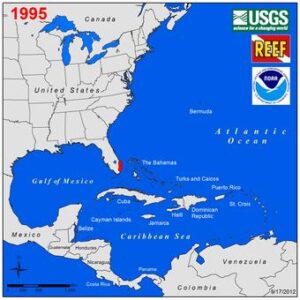Non-native invasive species like Burmese pythons, Brazilian pepper, and lionfish threaten Florida’s natural ecosystems and cost millions of dollars annually to control.
Non-native invasive species like Burmese pythons, Brazilian pepper, and lionfish threaten Florida’s natural ecosystems and cost millions of dollars annually to control.
What are invasive species? North American rabbits may seem benign, but after introduction to Australia and New Zealand, they caused serious ecological damage, having no natural predators to keep their numbers in check. The same is true of species brought to North America from elsewhere.
Lionfish have been described as one of the most aggressively invasive species on the planet. Native to the Indo-Pacific, the red lionfish (Pterois volitans) and the common lionfish (P. miles) have established themselves off the East Coast of the United States and in the Caribbean and are major threats to our coral reef systems and fisheries.


Currently, controlling lionfish is largely limited to divers spearing them, though work has begun on lionfish traps. Organizations such as RISE (Robots in Service of the Environment) have begun efforts to develop submersible lionfish-hunting robots that autonomously control lionfish populations. It may also be possible to manipulate lionfish genes to disrupt its ability to produce viable offspring. Our Foundation is working with the National Fish and Wildlife Foundation, the National Oceanic and Atmospheric Administration, the University of Georgia, and the Reef Environmental Education Foundation on acoustic and pheromone lures for traps and is also helping find effective biological or genetic controls.

Right behind the lionfish in its impact on Florida is the Burmese python (Python bivittatus), one of the five largest snakes in the world. One hundred thousand Burmese pythons were imported to the United States between 1996 and 2006 alone. A few released accidentally or intentionally by pet owners in South Florida have led to a large breeding population in the Everglades. Though more than 2,000 pythons have been removed from Everglades National Park and surrounding areas since 2002, thousands more remain.
These nonvenomous constrictors reproduce in great numbers and eat eggs, small mammals, birds and even deer and alligators. Their cryptic coloring makes them difficult to track in the wild, although putting radio transmitters on male pythons has helped locate other males and fertile females. For every python captured in South Florida, however, another 100 to 200 are believed to exist.
Unfortunately, other reptiles brought to the United States as pets have found their way into Florida’s wilds. Non-native Argentine Black and White Tegus, Iguanas, and Nile Monitor Lizards have become serious predators of native Florida wildlife. Iguanas also cause damage to landscaping and property. Additional research on controlling these species is needed.
Protecting wild Florida begins with you. From Pensacola Bay to Key West, our Foundation is working to protect Florida’s natural lands and waters and the wildlife they harbor.
Help ensure future generations can experience wild Florida by donating now.
